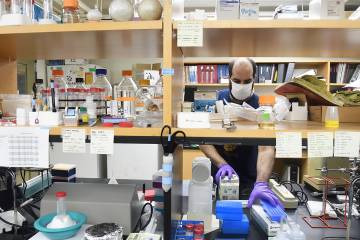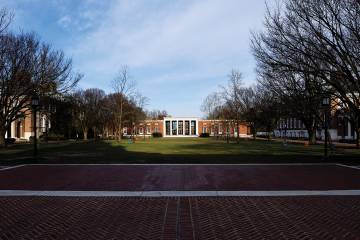Cross-divisional workgroups continue to study the issues, gather feedback, and draft plans about how Johns Hopkins University will emerge from a monthslong period of distancing prompted by the COVID-19 pandemic.
These efforts are leading to action: Faculty, staff, and graduate students based in labs with approved reopening plans began returning to campus June 15, becoming the first non-essential personnel on site since mid-March. They're following the health and safety protocols outlined for early-phase reopening in the recently finalized Return to Campus and Return to Research reports.
Other workgroups have gathered expert input and shared draft guidelines for resuming classes in the fall while prioritizing the educational and health and safety interests of students, as well as for testing, contact tracing, isolation, and quarantine.
The next set of recommendations, expected to be shared next week, will focus on the student experience in the fall, including plans for the instructional calendar, class formats, and exams outlined by the Academic Programs Workgroup. The Student Life Workgroup will also have plans focused on undergraduate concerns such as housing and dining, student activities, health and well-being, new student orientation, and Homewood facilities.
The graduate and professional schools will share their individual plans via email, town halls, and websites, through the first part of July. Comments and suggestions about the resumption of on-campus activities can be shared anytime online via the JHU 2020 Planning feedback form.
"Faculty and academic staff across every school have been mobilized for weeks in taking apart and putting back together plans for fall," said Stephen Gange, executive vice provost and professor of epidemiology. "New schedules, modalities, training, infrastructure, and accommodations are all underway with opportunities for consultation and feedback. We are working in accordance of our guiding principles to build a fall experience that maximizes, to the extent possible, the inherent benefits of our traditional togetherness with the expectations of continued COVID-19 disruptions."
Along with the workgroups for each area, several additional advisory committees are providing their expertise and perspectives across key topics. The Student Advisory Committee is made up of 20 graduate and undergraduate students representing all nine JHU academic divisions. The University Pandemic Academic Advisory Committee is a cross-divisional academic leadership group that works collaboratively with the president and provost, ensuring that all divisions' unique faculty needs and concerns are considered.
The university has also convened a Health Advisory Group, which brings together JHU faculty who are recognized nationally as experts in health security, epidemiology, and event preparedness, to share their expertise and guide the university's reopening plans.
"We are fortunate at Johns Hopkins to have some of the world's top experts in infection control and epidemiology, and to have a level of access to those experts that others do not enjoy," said Roy Ziegelstein, vice dean for education at the School of Medicine. Ziegelstein, a member of the Academic Programs Workgroup, said the university is also working closely with the Johns Hopkins Health System—especially for the supply and distribution of personal protective equipment—as well as with the city and state, accrediting bodies, national organizations, peer institutions, specialty organizations, and other professional clinical training programs,
"This has been a time when communication is absolutely critical," he said.
While the planning process continues, some adjustments are already underway. The university has already said that all schools will continue to make significant use of remote/online teaching and learning, as physical distancing measures on campus will drastically reduce the number of available seats in classrooms. In addition, some people may not return to campus or will be prevented from attending in-person classes, and every instructor must be prepared to regress to more restrictive public health phases requiring online-only instruction at any time during the academic year.
That is why much of the fall planning effort in the Whiting School of Engineering is focused on improving the online learning experience, said Sri Sarma, the Whiting School's vice dean for graduate education and a member of the Academic Programs Workgroup. While 92% of students who responded to the school's survey at the end of the spring semester said they were able to participate in virtual classes, 17% said they experienced technical issues with connectivity at their location, 4% noted technical issues running Zoom, and 5% had issues with the instructor managing Zoom.
"The rapid and unexpected transition was successful for the Whiting School, but it is clear we need to provide better connectivity for students and a more natural and safe instructional environment for our faculty during Fall 2020 instruction," Sarma said.
Every planning scenario for the fall semester includes online learning to some degree, and improvements are being planned to accommodate it, Sarma said, including the proposed construction of more than 35 learning studios on the Homewood campus. Each studio will be a teaching hub enabling faculty and lecturers to broadcast their classes using tablets, cameras, projectable white boards, and an audio system that will greatly improve upon the typical Zoom course experience.
At the Peabody Institute, Senior Associate Dean Abra Bush, also a member of the Academic Programs Workgroup, says they are hearing from students about how much they want to be back on site and in the community, while faculty are concerned about the health and safety protocols that will be in place.
Peabody is examining specific challenges around three groups of performers: singers, wind players (woodwinds and brass), and dancers, Bush says. "The singers and wind players are problematic as they produce aerosol emissions. As a result, we are working closely with Health and Safety, Infection Control, and others across the university to develop appropriate protocols to keep students and faculty in those areas safe and still able to perform on campus," she says. "The dancers are not unlike athletes, so we are closely following the protocols being put into place for athletics and coordinating with university officials to develop appropriate distancing and masking protocols for this unique group."
The School of Medicine is looking closely at how COVID-19 has affected students and trainees based on their roles and on whether their learning occurs primarily in classrooms and small group settings, in research laboratories, or at patients' bedsides, Ziegelstein said.
For some medical students early in their training, direct patient care was suspended or shifted to online experiences as a result of the pandemic. But many residents and clinical fellows are caring for COVID-19 patients, even if they came to Johns Hopkins for a very different training experience, Ziegelstein said.
Posted in University News









